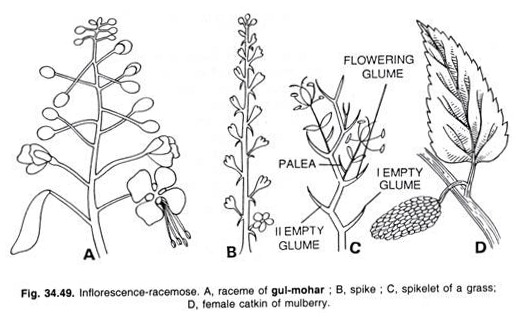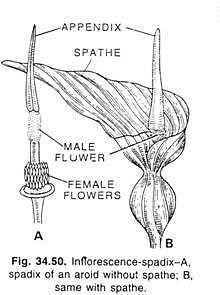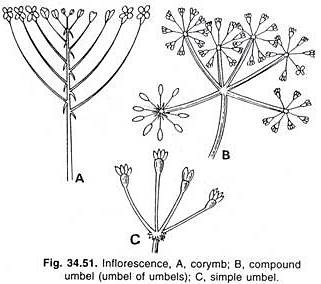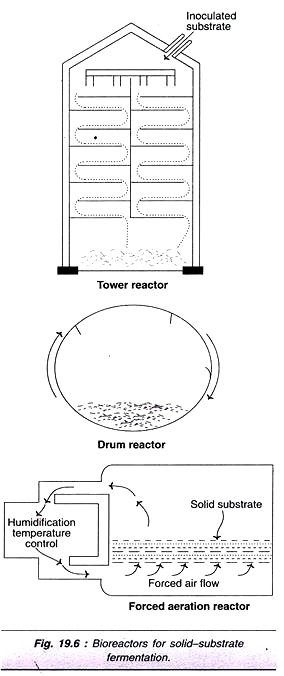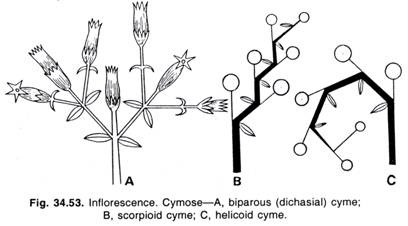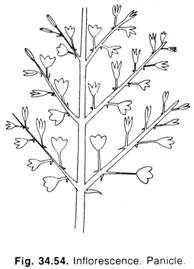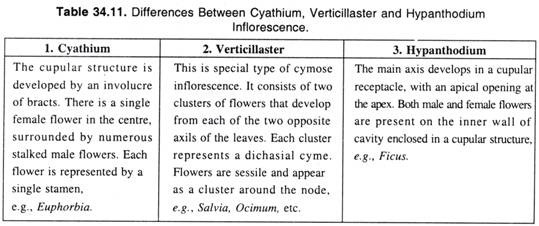The following points highlight the six major types of inflorescence. After reading this article you will learn about: 1. Racemose Inflorescence 2. Cymose Inflorescence 3. Compound 4. Cyathium 5. Verticillaster 6. Hypanthodium.
Contents
Inflorescence: Type # 1. Racemose Inflorescence:
In this type of inflorescence the main axis does not end in a flower, but it grows continuously and develops flowers on its lateral sides in acropetal succession (i.e., the lower or outer flowers are older than the upper or inner ones). The various forms of racemose inflorescence may be described under three heads.
They are as follows:
(i) With the main axis elongated, i.e., (a) raceme; (b) spike; (c) spikelets; (d) catkin and (e) spadix.
(ii) With the main axis shortened, i.e., (i) corymb and (ii) umbel.
(iii) With the main axis flattened, i.e., capitulum or head.
(i) Main Axis Elongated:
(a) Raceme:
In such cases the main axis remains elongated and it bears laterally a number of stalked flowers. The lower or older flowers possess longer stalks than the upper or younger ones, e.g., radish (Raphanus sativus), mustard (Brassica campestris), etc.
When the main axis of raceme is branched and the lateral branches bear the flowers, the inflorescence is known as compound raceme or panicle, e.g., neem (Azadirachta indica), gul-mohar (Delonix regia), etc.
The main axis of the inflorescence together with the latest axes, if present, is termed as the peduncle. The stalk of the individual flower of the inflorescence is called the pedicel.
(b) Spike:
In this type of racemose inflorescence the main axis remains elongated and the lower flowers are older, i.e., opening earlier than the upper ones, as found in raceme, but here the flowers are sessile, i.e., without pedicel or stalk, e.g., amaranth (Amaranthus spp.), latjira (Achyranthes aspera), etc.
(c) Spikelets:
Each spikelet may bear one to several flowers (florets) attached to a central stalk known as rachilla. Spikeletes are arranged in a spike inflorescence which is composed of several to many spikelets which are combined in various manners on a main axis called the rachis. Some are in compound spikes (i.e., in wheat—Triticum aestivum), others are in racemes (e.g., in Festuca), while some are in panicles (e.g., in Avena).
The usual structure of spikelet is as— There is a pair of sterile glumes at the base of spikelet, the lower, outer glume called the first, and the upper, inner one called the second. Just above the glumes, there is series of florets, partly enclosed by them.
Each floret has at its base a lemma and palea. The lemma is the lower, outer bract of the floret. Usually the lemma also known as inferior palea bears a long awn as an extension of the mid-rib at the apex or back.
The floral parts borne in the axil of lemma. The palea (also known as superior palea) often with two longitudinal ridges (keels or nerves), stands between the lemma and the rachilla. Flowers and glumes are arranged on the spikelet in two opposite rows. Spikeletes are characteristic of Poaceae (Gramineae) or Grass family, e.g., grasses, wheat, barley, oats, sorghum, sugarcane, bamboo, etc.
(d) Catkin:
This is a modified spike with a long and drooping axis bearing unisexual flowers, e.g., mulberry (Moras alba), birch (Betula spp.), oak (Quercus spp.), etc.
(e) Spadix:
This is also a modification of spike inflorescence having a fleshy axis, which remains enclosed by one or more large, often brightly coloured bracts, the spathes, e.g., in members of Araceae, Musaceae and Palmaceae. This inflorescence is found only in monocotyledonous plants.
(ii) Main Axis Shortened:
(a) Corymb:
In this inflorescence the main axis remains comparatively short and the lower flowers possess much longer stalks or pedicels than the upper ones so that all the flowers are brought more or less to the same level, e.g., in candytuft (Iberis amara).
(b) Umbel:
In this inflorescence the primary axis remains comparatively short, and it bears at its tip a group of flowers which possess pedicels or stalks of more or less equal lengths so that the flowers are seen to spread out from a common point. In this inflorescence a whorl of bracts forming an involucre is always present, and each individual flower develops from the axil of a bract.
Generally the umbel is branched and is known as umbel of umbels (compound umbel), and the branches bear flowers, e.g., in coriander (Coriandrum sativum), fennel, carrot, etc. Sometimes, the umbel is un-branched and known as simple umbel, e.g., Brahmi (Centella asiatica). This inflorescence (umbel) is characteristic of Apiaceae (Umbelliferae) family.
(iii) Main Axis Flattened:
Capitulum or Head:
In this type of inflorescence the main axis or receptacle becomes suppressed, and almost flat, and the flowers (also known as florets) are sessile (without stalk) so that they become crowded together on the flat surface of the receptacle. The florets are arranged in a centripetal manner on the receptacle, i.e., the outer flowers are older and open earlier than the inner ones.
The individual flowers (florets) are bracteate. In addition the whole inflorescence remains surrounded by a series of bracts arranged in two or three whorls.
The flowers (florets) are usually of two kinds:
(i) Ray florets (marginal strap-shaped flowers) and
(ii) Disc florets (central tubular flowers).
The capitulum (head) may also consist of only one kind of florets, e.g., only tubular florets in Ageratum or only ray or strap-shaped florets in Sonchus. A capitulum or head is characteristic of Asteraceae (Compositae) family, e.g., sunflower (Helianthus annuus), marigold (Tagetes indica), safflower (Carthamus tinctorius). Zinnia, Cosmos, Tridax, Vernonia, etc. Besides, it is also found in Acacia and sensitive plant (Mimosa pudica) of Mimosaceae family.
The capitulum inflorescence has been considered to be the most perfect. The reasons are as follows:
The individual flowers are quite small and massed together in heads, and therefore, they add to greater conspicuousness to attract the insects and flies for pollination.
At the same time there is a considerable saving of material in the construction of the corolla and other floral parts.
A single insect may pollinate flowers in a short time without flying from one flower to another.
Inflorescence: Type # 2. Cymose Inflorescence:
In this type of inflorescence the growth of the main axis is ceased by the development of a flower at its apex, and the lateral axis which develops the terminal flower also culminates in a flower and its growth is also ceased. The flowers may be pedicellate (stalked) or sessile (without stalk).
Here the flowers develop in basipetal succession, i.e., the terminal flower is the oldest and the lateral ones younger. This type of opening of flowers is known as centrifugal.
The cymose inflorescence may be of four main types:
(i) Uniparous or monochasial cyme;
(ii) Biparous or dichasial cyme;
(iii) Multiparous or polychasial cyme and
(iv) Cymose capitulum.
(i) Uniparous or Monochasial Cyme:
Here the main axis ends in a flower and it produces only one lateral branch at a time ending in a flower. The lateral and succeeding branches again produce only one branch at a time like the primary one.
There are three forms of uniparous cyme:
(a) Helicoid,
(b) Scorpioid, and
(c) Sympodial
(a) Helicoid Cyme:
When the lateral axes develop successively on the same side, forming a sort of helix, the cymose inflorescence is known as helicoid or one-sided cyme, e.g., in Begonia, Juncus, Hemerocallis and some members of Solanaceae.
(b) Scorpioid Cyme:
When the lateral branches develop on alternate sides, forming a zigzag, the cymose inflorescence is known as scorpioid or alternate-sided cyme, e.g., in Gossypium (cotton), Drosera (sundew), Heliotropium, Freesia, etc.
(c) Symopodial Cyme:
Sometimes, in monochasial or uniparous cyme successive axes may be at first curved or zig-zag (as in scorpioid cyme) but later on it becomes straight due to rapid growth, thus forming a central or pseudoaxis. This type of inflorescence is known as sympodial cyme as found in some members of Solanaceae (e.g., Solanum nigrum).
(ii) Biparous or Dichasial Cyme:
In this type of inflorescence the peduncle bears a terminal flower and stops growing. At the same time the peduncle produces two lateral younger flowers or two lateral branches each of which terminates in a flower.
There are three flowers; the oldest one is in the centre. The lateral and succeeding branches in their turn behave in the same manner, e.g., jasmine, teak, Ixora, Saponaria, etc. This is also known as true cyme or compound dichasium.
(iii) Multiparous or Polychasial Cyme:
In this type of cymose inflorescence the main axis culminates in a flower, and at the same time it again produces a number of lateral flowers around. The oldest flower is in the centre and ends the main floral axis (peduncle). This is a simple polychasium.
The whole inflorescence looks like an umbel, but is readily distinguished from the latter by the opening of the middle flower first, e.g., Ak (Calotropis procera), Hamelia patens, etc.
(iv) Cymose Capitulum:
This type of inflorescence is found in Acacia, Mimosa and Albizzia. In such cases the peduncle is reduced or condensed to a circular disc. It bears sessile or sub-sessile flowers on it. The oldest flowers develop in the centre and youngest towards the periphery of the disc, such arrangement is known as centrifugal. The flowers make a globose head, which is also called glomerule.
Inflorescence: Type # 3. Compound Inflorescence:
In this type of inflorescence the main axis (peduncle) branches repeatedly once or twice in racemose or cymose manner. In the former case it becomes a compound raceme and in the latter case it becomes a compound cymose inflorescence.
The main types of compound inflorescence are as follows:
1. Compound Raceme or Panicle:
In this case the raceme is branched, and the branches bear flowers in a racemose manner, e.g., Delonix regia, Azadirachta indica, Clematis buchaniana, Cassia fistula, etc.
2. Compound Umbel:
Also known as umbel of umbels. Here the peduncle (main axis) is short and bears many branches which arise in an umbellate cluster. Each such branch bears a group of flowers in an umbellate manner. Usually a whorl of leafy bracts is found at the base of branches and also at the bases of flowers arranged in umbellate way.
The former whorl of bracts is called involucre and the latter involucel. Typical examples of compound umbel are—Daucus carota (carrot), Foeniculum vulgare (fennel), Coriandrum sativum (coriander), etc.
3. Compound Corymb:
Also known as corymb of corymbs. Here the main axis (peduncle) branches in a corymbose manner and each branch bears flowers arranged in corymbs. Typical example-cauliflower.
4. Compound Spike:
Also known as spike of spikelets. The typical examples are found in Poaceae (Gramineae) family such as-wheat, barley, sorghum, oats, etc. This type has already been described under sub-head spikelets.
5. Compound Spadix:
Also known as spadix of spadices. Here the main axis (peduncle) remains branched in a racemose manner and each branch bears sessile and unisexual flowers. The whole branched structure remains covered by a single spathe. The examples are common in Palmaceae (Palmae) family.
6. Compound Head:
Also known as head of heads or capitulum of capitula. In this case many small heads form a large head. The typical example is globe thistle (Echinops). In this plant the heads are small and one-flowered and are arranged together forming a big compound head.
Inflorescence: Type # 4. Cyathium:
This type of inflorescence is found in genus Euphorbia of family Euphorbiaceae; also found in genus Pedilanthus of the family. In this inflorescence there is a cup-shaped involucre, often provided with nectar secreting glands. The involucre encloses a single female flower, represented by a pistil, in the centre, situated on a long stalk.
This female flower remains surrounded by a number of male flowers arranged centrifugally. Each male flower is reduced to a solitary stalked stamen. It is evident that each stamen is a single male flower from the facts that it is articulated to a stalk and that it possesses a scaly bract at the base. The examples can be seen in poinsettia (Euphorbia), Pedilanthus, etc.
Inflorescence: Type # 5. Verticillaster:
This type of inflorescence is a condensed form of dichasial (biparous) cyme with a cluster of sessile or sub-sessile flowers in the axil of a leaf, forming a false whorl of flowers at the node. The first of main floral axis gives rise to two lateral branches and these branches and the succeeding branches bear only one branch each on alternate sides.
The type of inflorescence is characteristic of Lamiaceae (Labiatae) family. Typical examples, are—Ocimum, Coleus, Mentha, Leucas, etc.
Inflorescence: Type # 6. Hypanthodium:
In this type of inflorescence the receptacle forms a hollow cavity with an apical opening guarded by scales. Here the flowers are borne on the inner wall of the cavity. The flowers are unisexual; the female flowers develop at the base of the cavity and the male flowers towards the apical pore. The examples are found in genus Ficus of Moraceae family, e.g., Ficus carica, F. glomerata, F. benghal- ensis, F. religiosa, etc.
